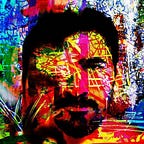Fellow Artist: Amy Clarke, Exploring the limitations
The moment I saw my first Jackson Pollock and understood that I was an artist, I was also taken by a wish that continued to emerge every time I went to see art. It was how cool it would be to pick the brain of those artists whose works moved me, intrigued me or challenged me. In 2017 I created an invitation-only blog project titled “Fellow Artists.” I did it for a year, not in hopes to become an art critic or journalist, but to welcome the opportunity to realize that wish that still visited in the work of peers and artists I crossed paths with. Most were very generous to answer my informal questions, not only about art, but also about themselves as people. As I began rebuilding my new website/blog and re-published those entries for posterity, I was inspired once again and immediately thought of the artists I would invite if I started the series again. Amy Clarke is one of those artists and the first installment in the series. As I read about Amy’s thought provoking approach and process, I’m glad I started the series again.
Transfusion, 2021. watercolor on paper.
What was your awakening?
I always felt this urge to feel way too deeply. I was longing for the real Amy and a deeper connection within the relationship I have with myself. To accept these strong emotions and feelings, I began to create a response- physical and emotional- visually. These responses then dictated my visuals. I found structure and a new found self-appreciation through texture and visually expressing this sense of longing and desire. I explored the limitations of sexuality- how sexuality builds walls- personally and interpersonally and in society. This is where I currently am but I know I have a long journey ahead. This is my foundation to build upon.
When did you get initiated in art-making and at what point did you decide to get out there as an artist?
I decided to start sharing my work when I felt like I was exploring and showing my feelings in a way that brought me a physical sense of relief. I’d create something and suddenly feel like I could breathe again. I felt this most when I started using band aids as a mechanism of showing pain but also growth.
At The Park, 2020. watercolor on paper
Your work seems charged with secrecy. How do you describe your work?
I believe all contemporary art is on the spectrum of secrecy. I paint what I like, but no one knows the complete meaning and feelings that are charged in each work. The beauty is that the viewer has the chance to respond to it in any way they please.
They can walk by and not care about what’s in front of them. But the people that do look and approach it and ultimately feel from it and relate to it is the reason why I create my art.
Describe your workspace.
My work space is my bedroom. Every step of the process occurs in my bedroom. From the initial thinking and idea, to painting and finishing the piece. My bed has always been my safe place. Being in my bed and sleeping is my escape from the world- in this space I can be my true self- I’m alone and it usually occurs at night when everyone else is sleeping.
Victory,2021. watercolor on paper.
Is your palette a deliberate choice or something you arrived at?
I only use colors that I truly feel drawn to or have created a special feeling towards. Pinks/reds/browns = the elements of the human body… the heart, the brain, the skin, the lips, blood. As well as blues= tears, water, the sky, sadness, but also hope.
Who are your influences?
I have many influences but one of my keystone influences is Mr. Robert Sorensen, he was my senior year of high school art teacher. He was the first art teacher that allowed me an entire year to work on whatever I wanted. He handed me a canvas and said- go for it. He didn’t set a deadline on the work and never attempted to influence what I should make. Up until that point I had taken art classes my entire life- but never felt I had the space to make what my heart was telling me to make.
BandAidII, 2020. Watercolor and bandaids on watercolorpaper.
The wounds appear to be recent and the band-aids can’t seem to conceal. Why?
My use of band aids in my transformation series looks at mental trauma and harm. Most wounds whether they are bruises, cuts, or broken bones will heal and eventually disappear. With the band aids in these pieces I am trying to see the open wounds and scars that mental abuse can cause. The pain is not visible but at times can be more painful.
Can one be transformed without trauma?
Of course. Positive experiences have led to my most significant and crucial transformations.
Somewhere, 2020. watercolor on paper.
What does photography offer for you?
Photography is my way of capturing a moment in time- more like a specific feeling. It pulls from my strong sense of nostalgia. I like photographing my loved ones. An image can bring me to tears if it sparks a lost memory or incorporates an impactful person, a previous/current relationship, or an experience in my lifetime.
Are you planning a transition into canvas?
The blank state of a white canvas makes me sad and I don’t feel drawn to it whatsoever. I’d rather use plywood or other random surfaces like manila folders, cardboard, or an envelope.
What’s next?
Who knows… the transformations and new approaches to my artwork happen in split seconds. It’s something I can’t plan. Though- I would like to incorporate embroidery or textiles into my works when the time feels right.
More about Amy:
